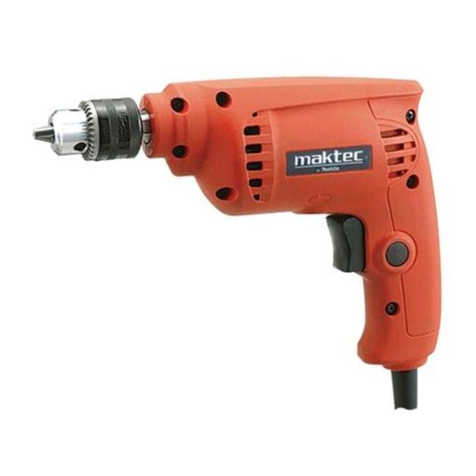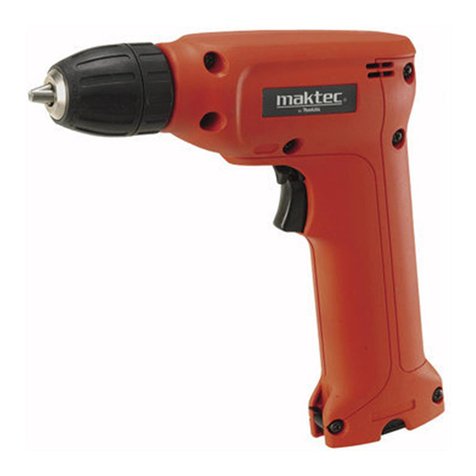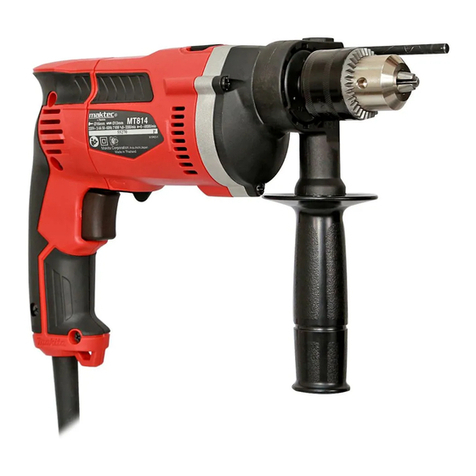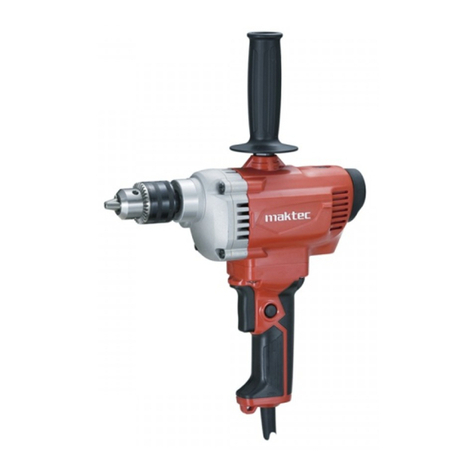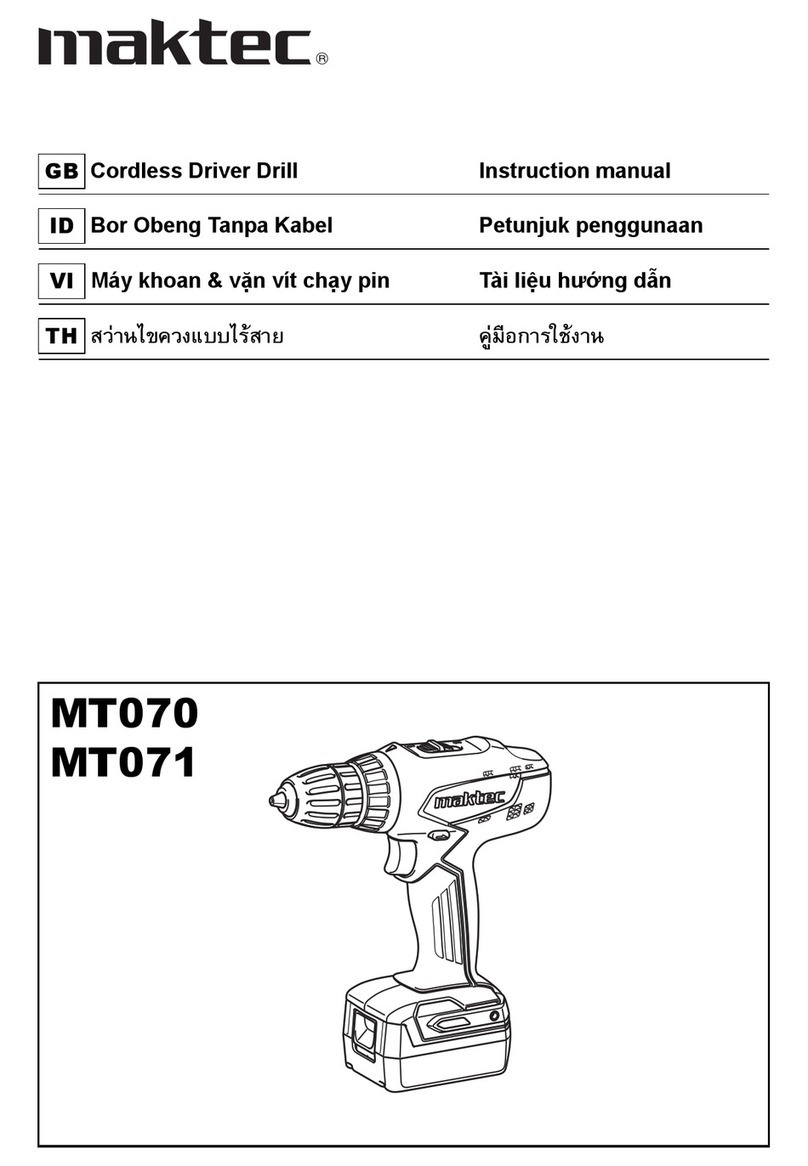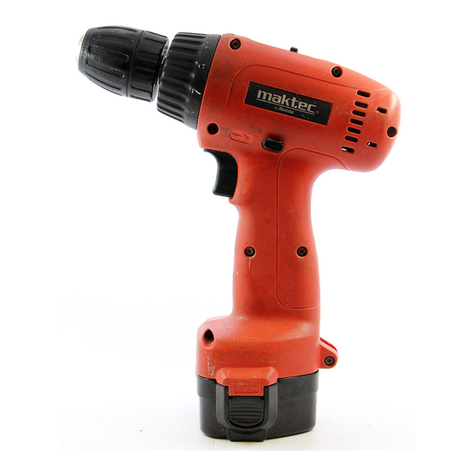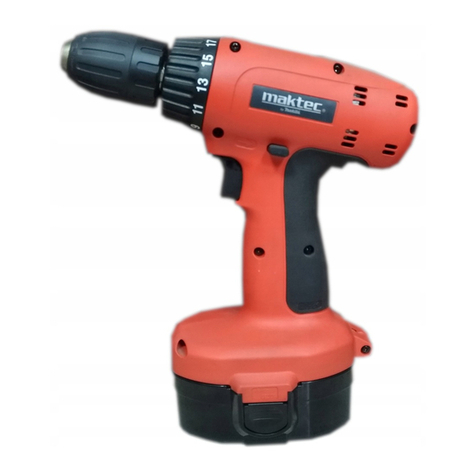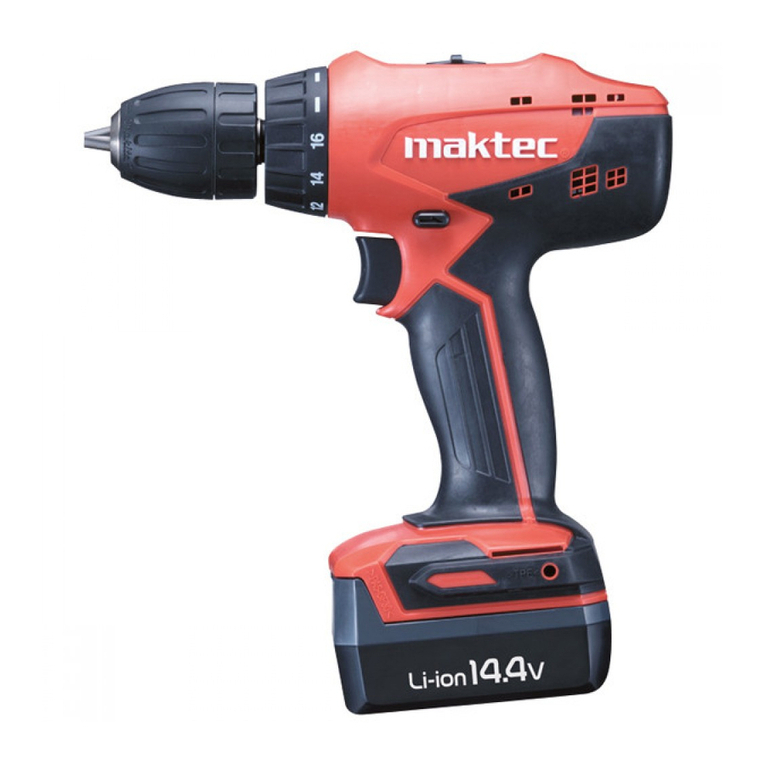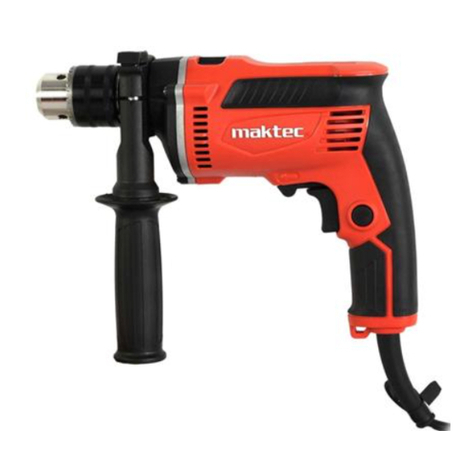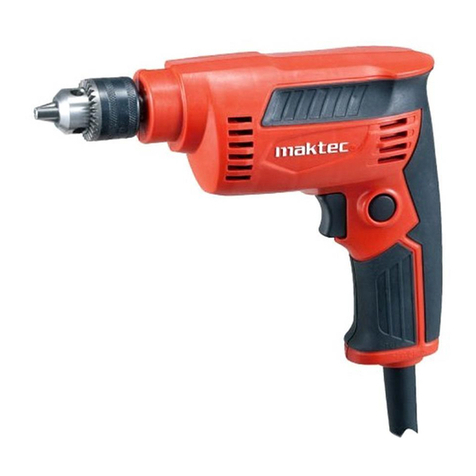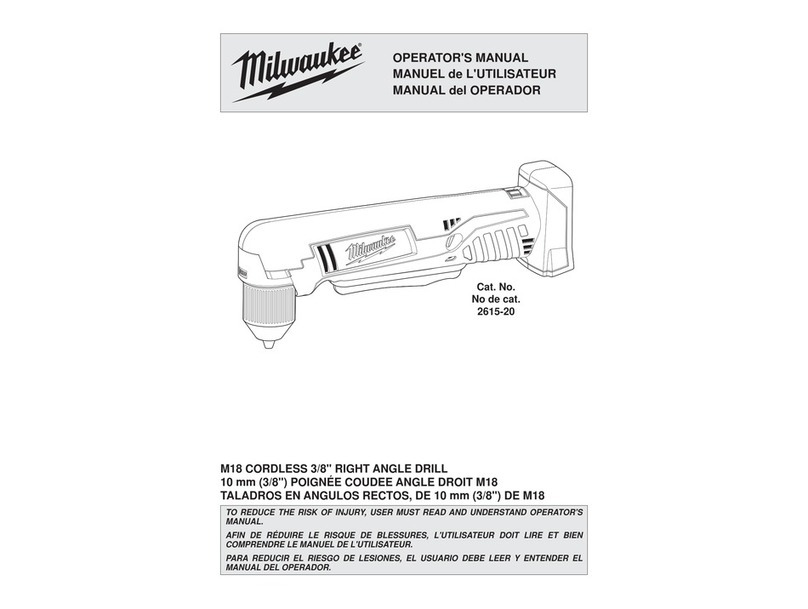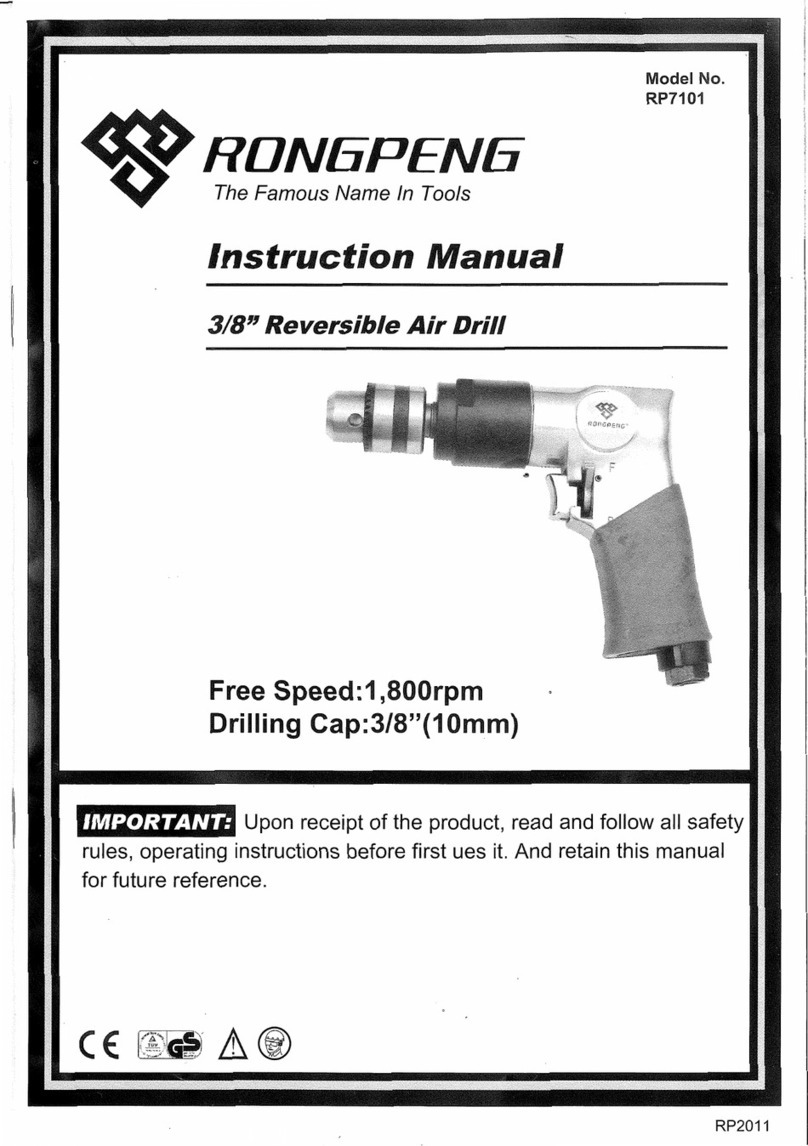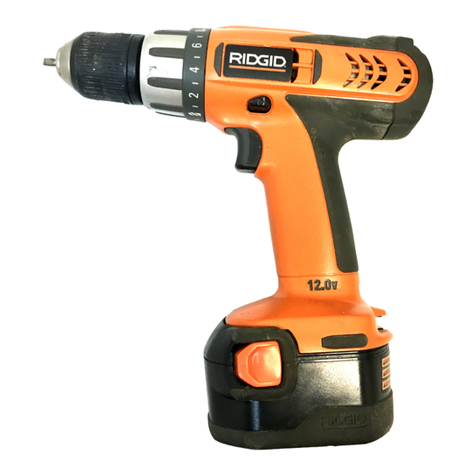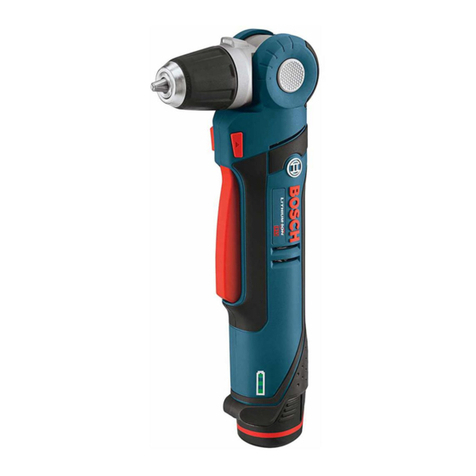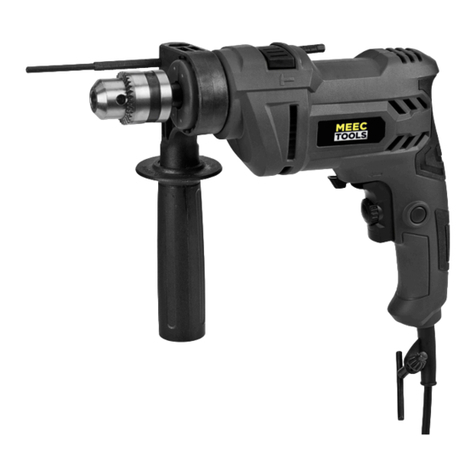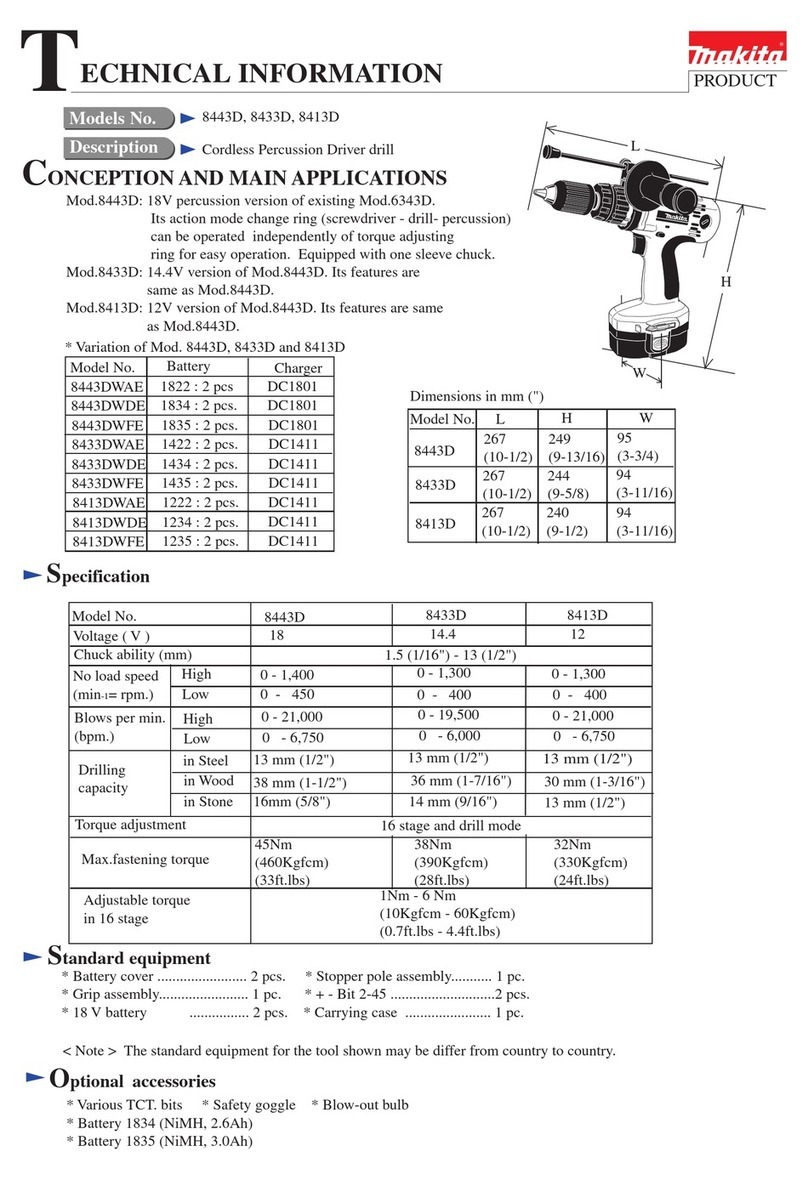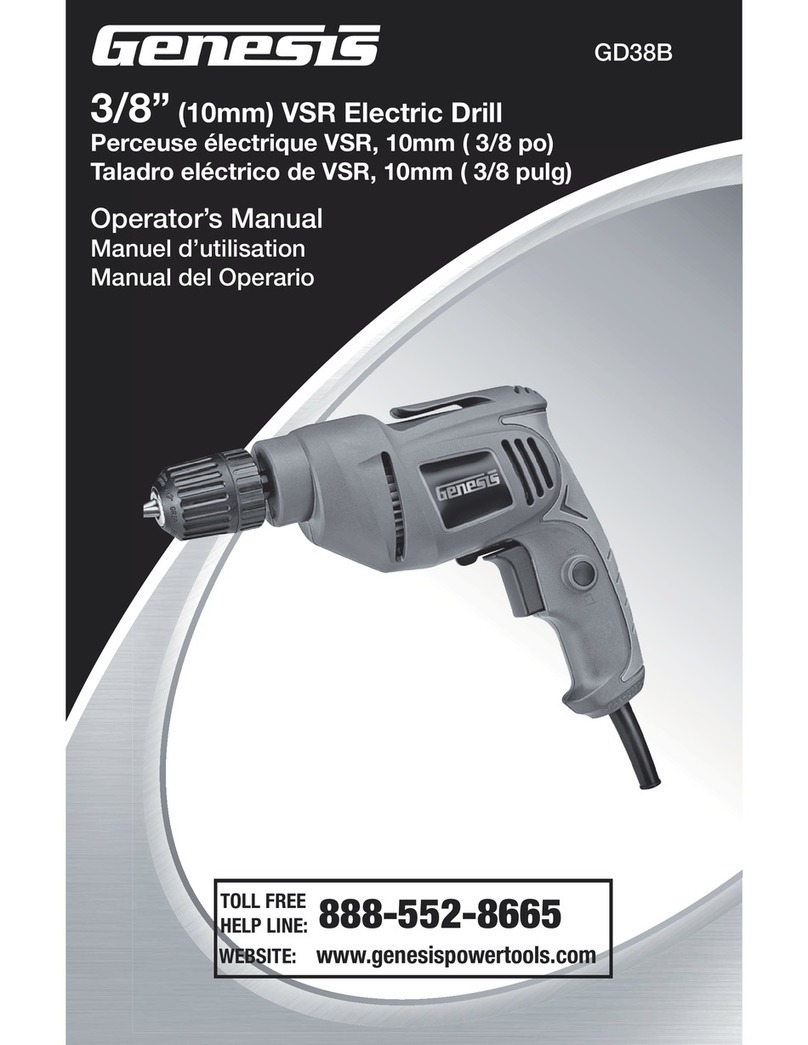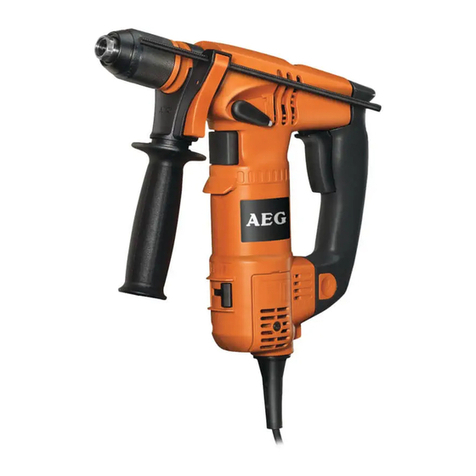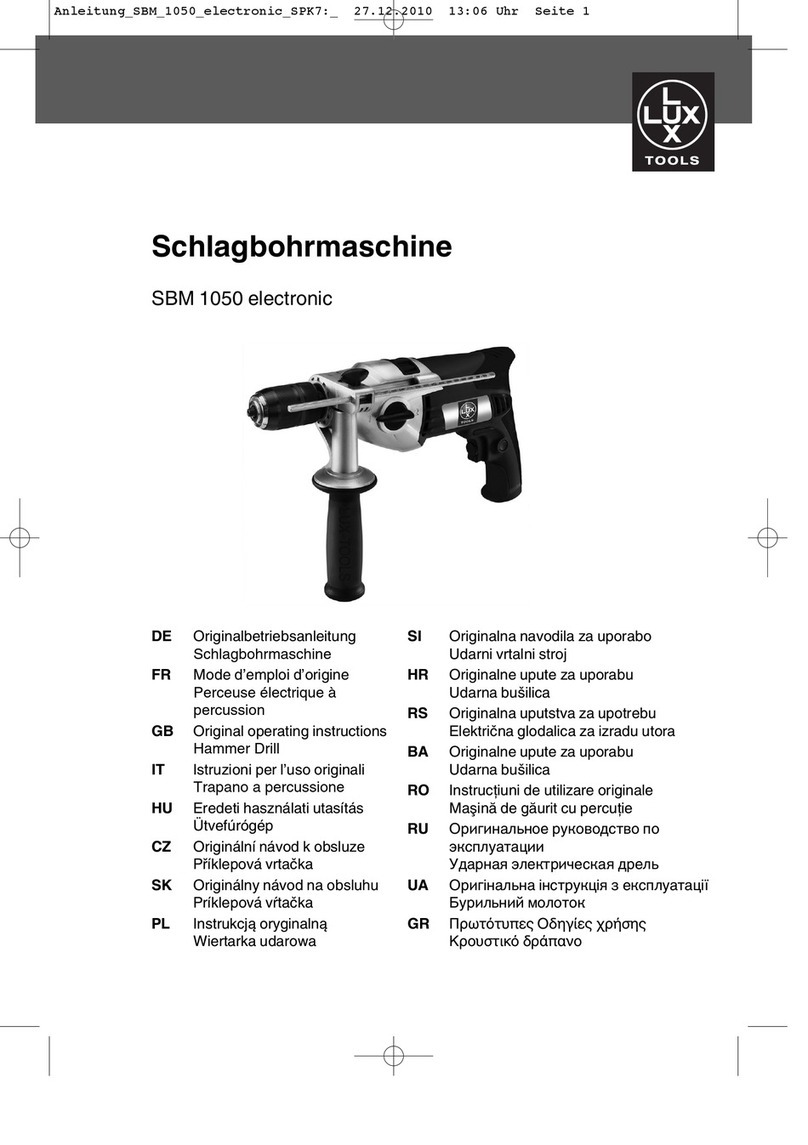Maktec HP347D User manual

GB Cordless Hammer Driver Drill Instruction manual
ZHCN
充电式冲击起子电钻 使用说明书
ID Bor Obeng Getar Tanpa Kabel Petunjuk penggunaan
Máy Khoan Búa Và Vặn Vít Cầm
Tay Hoạt Động Bằng Pin
VI Tài liệu hướng dẫn
TH สว่านไขควงตอกแบบไร้สาย คู่มือการใช้งาน
HP347D
HP457D

2
1011787 2011788
3011789 4011790
5011791 6011792
7002449 8011793
1
23
4
5
AB
6
7
8
9
10
11
12

3
ENGLISH
Explanation of general view
SPECIFICATIONS
• Due to our continuing programme of research and development, the specifications herein are subject to change without
notice.
• Specifications and battery cartridge may differ from country to country.
• Weight, with battery cartridge, according to EPTA-Procedure 01/2003
END004-4
Symbols
The following show the symbols used for the equipment.
Be sure that you understand their meaning before use.
..... Read instruction manual.
ENE039-1
Intended use
The tool is intended for impact drilling in brick, concrete
and stone as well as for drilling without impact in wood,
metal, ceramic and plastic.
GEA006-2
General Power Tool Safety
Warnings
WARNING! Read all safety warnings and all
instructions. Failure to follow the warnings and
instructions may result in electric shock, fire and/or
serious injury.
Save all warnings and
instructions for future reference.
The term “power tool” in the warnings refers to your
mains-operated (corded) power tool or battery-operated
(cordless) power tool.
Work area safety
1. Keep work area clean and well lit. Cluttered or dark
areas invite accidents.
2. Do not operate power tools in explosive
atmospheres, such as in the presence of
flammable liquids, gases or dust. Power tools
create sparks which may ignite the dust or fumes.
3. Keep children and bystanders away while
operating a power tool. Distractions can cause you
to lose control.
Electrical safety
4. Power tool plugs must match the outlet. Never
modify the plug in any way. Do not use any
adapter plugs with earthed (grounded) power
tools. Unmodified plugs and matching outlets will
reduce risk of electric shock.
5. Avoid body contact with earthed or grounded
surfaces such as pipes, radiators, ranges and
refrigerators. There is an increased risk of electric
shock if your body is earthed or grounded.
6. Do not expose power tools to rain or wet
conditions. Water entering a power tool will increase
the risk of electric shock.
7. Do not abuse the cord. Never use the cord for
carrying, pulling or unplugging the power tool.
Keep cord away from heat, oil, sharp edges or
moving parts. Damaged or entangled cords increase
the risk of electric shock.
1. Red indicator
2. Button
3. Battery cartridge
4. Switch trigger
5. Reversing switch lever
6. Speed change lever
7. Adjusting ring
8. Action mode changing ring
9. Graduation
10. Arrow
11. Sleeve
12. Blow-out bulb
Model HP347D HP457D
Capacities
Concrete 10 mm 13 mm
Steel 10 mm 13 mm
Wood 25 mm 36 mm
Wood screw 5.1 mm x 63 mm 6 mm x 75 mm
Machine screw 6 mm
No load speed (min-1)High (2) 0 - 1,400
Low (1) 0 - 400
Blows per minute (min-1)High (2) 0 - 21,000
Low (1) 0 - 6,000
Overall length North/South America 216 mm 246 mm
Other countries 239 mm
Net weight 1.5 kg 1.7 kg
Rated voltage D.C. 14.4 V D.C. 18 V

4
8. When operating a power tool outdoors, use an
extension cord suitable for outdoor use. Use of a
cord suitable for outdoor use reduces the risk of
electric shock.
9. If operating a power tool in a damp location is
unavoidable, use a ground fault circuit interrupter
(GFCI) protected supply. Use of an GFCI reduces
the risk of electric shock.
Personal safety
10. Stay alert, watch what you are doing and use
common sense when operating a power tool. Do
not use a power tool while you are tired or under
the influence of drugs, alcohol or medication. A
moment of inattention while operating power tools
may result in serious personal injury.
11. Use personal protective equipment. Always wear
eye protection. Protective equipment such as dust
mask, non-skid safety shoes, hard hat, or hearing
protection used for appropriate conditions will reduce
personal injuries.
12. Prevent unintentional starting. Ensure the switch
is in the off-position before connecting to power
source and/or battery pack, picking up or carrying
the tool. Carrying power tools with your finger on the
switch or energising power tools that have the switch
on invites accidents.
13. Remove any adjusting key or wrench before
turning the power tool on. A wrench or a key left
attached to a rotating part of the power tool may result
in personal injury.
14. Do not overreach. Keep proper footing and
balance at all times. This enables better control of
the power tool in unexpected situations.
15. Dress properly. Do not wear loose clothing or
jewellery. Keep your hair, clothing, and gloves
away from moving parts. Loose clothes, jewellery or
long hair can be caught in moving parts.
16. If devices are provided for the connection of dust
extraction and collection facilities, ensure these
are connected and properly used. Use of dust
collection can reduce dust-related hazards.
Power tool use and care
17. Do not force the power tool. Use the correct power
tool for your application. The correct power tool will
do the job better and safer at the rate for which it was
designed.
18. Do not use the power tool if the switch does not
turn it on and off. Any power tool that cannot be
controlled with the switch is dangerous and must be
repaired.
19. Disconnect the plug from the power source and/or
the battery pack from the power tool before
making any adjustments, changing accessories,
or storing power tools. Such preventive safety
measures reduce the risk of starting the power tool
accidentally.
20. Store idle power tools out of the reach of children
and do not allow persons unfamiliar with the
power tool or these instructions to operate the
power tool. Power tools are dangerous in the hands
of untrained users.
21. Maintain power tools. Check for misalignment or
binding of moving parts, breakage of parts and
any other condition that may affect the power
tool’s operation. If damaged, have the power tool
repaired before use. Many accidents are caused by
poorly maintained power tools.
22. Keep cutting tools sharp and clean. Properly
maintained cutting tools with sharp cutting edges are
less likely to bind and are easier to control.
23. Use the power tool, accessories and tool bits etc.
in accordance with these instructions, taking into
account the working conditions and the work to
be performed. Use of the power tool for operations
different from those intended could result in a
hazardous situation.
Battery tool use and care
24. Recharge only with the charger specified by the
manufacturer. A charger that is suitable for one type
of battery pack may create a risk of fire when used
with another battery pack.
25. Use power tools only with specifically designated
battery packs. Use of any other battery packs may
create a risk of injury and fire.
26. When battery pack is not in use, keep it away from
other metal objects, like paper clips, coins, keys,
nails, screws or other small metal objects, that can
make a connection from one terminal to another.
Shorting the battery terminals together may cause
burns or a fire.
27. Under abusive conditions, liquid may be ejected
from the battery; avoid contact. If contact
accidentally occurs, flush with water. If liquid
contacts eyes, additionally seek medical help.
Liquid ejected from the battery may cause irritation or
burns.
Service
28. Have your power tool serviced by a qualified
repair person using only identical replacement
parts. This will ensure that the safety of the power tool
is maintained.
29. Follow instruction for lubricating and changing
accessories.
30. Keep handles dry, clean and free from oil and
grease.
GEB056-3
CORDLESS HAMMER DRILL
SAFETY WARNINGS
1. Wear ear protectors when impact drilling.
Exposure to noise can cause hearing loss.
2. Use auxiliary handle(s), if supplied with the tool.
Loss of control can cause personal injury.
3. Hold power tool by insulated gripping surfaces,
when performing an operation where the cutting
accessory may contact hidden wiring. Cutting
accessory contacting a “live” wire may make exposed
metal parts of the power tool “live” and could give the
operator an electric shock.
4. Always be sure you have a firm footing.
Be sure no one is below when using the tool in
high locations.
5. Hold the tool firmly.
6. Keep hands away from rotating parts.

5
7. Do not leave the tool running. Operate the tool
only when hand-held.
8. Do not touch the bit or the workpiece immediately
after operation; they may be extremely hot and
could burn your skin.
9. Some material contains chemicals which may be
toxic. Take caution to prevent dust inhalation and
skin contact. Follow material supplier safety data.
SAVE THESE INSTRUCTIONS.
WARNING:
DO NOT let comfort or familiarity with product (gained
from repeated use) replace strict adherence to safety
rules for the subject product. MISUSE or failure to
follow the safety rules stated in this instruction
manual may cause serious personal injury.
ENC009-1
IMPORTANT SAFETY
INSTRUCTIONS
FOR BATTERY CARTRIDGE
1. Before using battery cartridge, read all
instructions and cautionary markings on (1)
battery charger, (2) battery, and (3) product using
battery.
2. Do not disassemble battery cartridge.
3. If operating time has become excessively shorter,
stop operating immediately. It may result in a risk
of overheating, possible burns and even an
explosion.
4. If electrolyte gets into your eyes, rinse them out
with clear water and seek medical attention right
away. It may result in loss of your eyesight.
5. Do not short the battery cartridge:
(1) Do not touch the terminals with any
conductive material.
(2) Avoid storing battery cartridge in a container
with other metal objects such as nails, coins,
etc.
(3) Do not expose battery cartridge to water or
rain.
A battery short can cause a large current flow,
overheating, possible burns and even a
breakdown.
6. Do not store the tool and battery cartridge in
locations where the temperature may reach or
exceed 50°C (122°F).
7. Do not incinerate the battery cartridge even if it is
severely damaged or is completely worn out. The
battery cartridge can explode in a fire.
8. Be careful not to drop or strike battery.
9. Do not use a damaged battery.
SAVE THESE INSTRUCTIONS.
Tips for maintaining maximum battery life
1. Charge the battery cartridge before completely
discharged.
Always stop tool operation and charge the battery
cartridge when you notice less tool power.
2. Never recharge a fully charged battery cartridge.
Overcharging shortens the battery service life.
3. Charge the battery cartridge with room
temperature at 10°C - 40°C (50°F - 104°F). Let a hot
battery cartridge cool down before charging it.
FUNCTIONAL DESCRIPTION
CAUTION:
• Always be sure that the tool is switched off and the
battery cartridge is removed before adjusting or
checking function on the tool.
Installing or removing battery cartridge
(Fig. 1)
• Always switch off the tool before installing or removing
of the battery cartridge.
• To remove the battery cartridge, slide it from the tool
while sliding the button on the front of the cartridge.
• To install the battery cartridge, align the tongue on the
battery cartridge with the groove in the housing and slip
it into place. Always insert it all the way until it locks in
place with a little click. If you can see the red indicator
on the upper side of the button, it is not locked
completely. Install it fully until the red indicator cannot
be seen. If not, it may accidentally fall out of the tool,
causing injury to you or someone around you.
• Do not use force when installing the battery cartridge. If
the cartridge does not slide in easily, it is not being
inserted correctly.
Battery protection system
The battery cartridge is equipped with the protection
system, which automatically cuts off the output power for
its long service life.
The tool stops during operation when the tool and/or
battery are placed under the following situation. This is
caused by the activation of protection system and does
not show the tool trouble.
• When the tool is overloaded:
At this time, release the switch trigger, remove the
battery cartridge and remove causes of overload
and then pull the switch trigger again to restart.
• When battery cells get hot:
If any operation of the switch trigger, the motor will
remain stopped. At this time, stop use of the tool
and cool the battery cartridge.
• When the remaining battery capacity gets low:
If you pull the switch trigger, the motor runs again
but stops soon. In this case, to prevent over
discharge, remove the battery cartridge from the
tool and charge it.
Switch action (Fig. 2)
CAUTION:
• Before inserting the battery cartridge into the tool,
always check to see that the switch trigger actuates
properly and returns to the “OFF” position when
released.
To start the tool, simply pull the switch trigger. Tool speed
is increased by increasing pressure on the switch trigger.
Release the switch trigger to stop.

6
Reversing switch action (Fig. 3)
This tool has a reversing switch to change the direction of
rotation. Depress the reversing switch lever from the A
side for clockwise rotation or from the B side for
counterclockwise rotation.
When the reversing switch lever is in the neutral position,
the switch trigger cannot be pulled.
CAUTION:
• Always check the direction of rotation before operation.
• Use the reversing switch only after the tool comes to a
complete stop. Changing the direction of rotation
before the tool stops may damage the tool.
• When not operating the tool, always set the reversing
switch lever to the neutral position.
Speed change (Fig. 4)
To change the speed, first switch off the tool and then
slide the speed change lever to the “2” side for high speed
or “1” side for low speed. Be sure that the speed change
lever is set to the correct position before operation. Use
the right speed for your job.
CAUTION:
• Always set the speed change lever fully to the correct
position. If you operate the tool with the speed change
lever positioned halfway between the “1” side and “2”
side, the tool may be damaged.
• Do not use the speed change lever while the tool is
running. The tool may be damaged.
Selecting the action mode (Fig. 5)
This tool employs an action mode changing ring. Select
one of the three modes suitable for your work needs by
using this ring.
For rotation only, turn the ring so that the arrow on the tool
body points toward the mark on the ring.
For rotation with hammering, turn the ring so that the
arrow points toward the mark on the ring.
For rotation with clutch, turn the ring so that the arrow
points toward the mark on the ring.
CAUTION:
• Always set the ring correctly to your desired mode
mark. If you operate the tool with the ring positioned
halfway between the mode marks, the tool may be
damaged.
Adjusting the fastening torque (Fig. 5)
The fastening torque can be adjusted in 16 steps by
turning the adjusting ring so that its graduations are
aligned with the arrow on the tool body. The fastening
torque is minimum when the number 1 is aligned with the
arrow, and maximum when the number 16 is aligned with
the arrow.
Before actual operation, drive a trial screw into your
material or a piece of duplicate material to determine
which torque level is required for a particular application.
ASSEMBLY
CAUTION:
• Always be sure that the tool is switched off and the
battery cartridge is removed before carrying out any
work on the tool.
Installing or removing driver bit or drill bit
(Fig. 6)
Turn the sleeve counterclockwise to open the chuck jaws.
Place the bit in the chuck as far as it will go. Turn the
sleeve clockwise to tighten the chuck.
To remove the bit, turn the sleeve counterclockwise.
OPERATION
Hammer drilling operation
CAUTION:
• There is a tremendous and sudden twisting force
exerted on the tool/bit at the time of hole break-
through, when the hole becomes clogged with chips
and particles, or when striking reinforcing rods
embedded in the concrete.
First, turn the action mode changing ring so that the arrow
on the tool body points to the marking. The adjusting
ring can be aligned in any torque levels for this operation.
Be sure to use a tungsten-carbide tipped bit.
Position the bit at the desired location for the hole, then
pull the switch trigger. Do not force the tool. Light pressure
gives best results. Keep the tool in position and prevent it
from slipping away from the hole.
Do not apply more pressure when the hole becomes
clogged with chips or particles. Instead, run the tool at an
idle, then remove the bit partially from the hole. By
repeating this several times, the hole will be cleaned out
and normal drilling may be resumed.
Blow-out bulb (optional accessory)
(Fig. 7)
After drilling the hole, use the blow-out bulb to clean the
dust out of the hole.
Screwdriving operation (Fig. 8)
First, turn the action mode changing ring so that the arrow
on the tool body points to the marking. Adjust the
adjusting ring to the proper torque level for your work.
Then proceed as follows.
Place the point of the driver bit in the screw head and
apply pressure to the tool. Start the tool slowly and then
increase the speed gradually. Release the switch trigger
as soon as the clutch cuts in.
CAUTION:
• Make sure that the driver bit is inserted straight in the
screw head, or the screw and/or bit may be damaged.
NOTE:
• When driving wood screws, predrill pilot holes to make
driving easier and to prevent splitting of the workpiece.
See the chart.

7
006421
Drilling operation
First, turn the adjusting ring so that the pointer points to
the marking. Then proceed as follows.
CAUTION:
• Pressing excessively on the tool will not speed up the
drilling. In fact, this excessive pressure will only serve
to damage the tip of your bit, decrease the tool
performance and shorten the service life of the tool.
• There is a tremendous force exerted on the tool/bit at
the time of hole break through. Hold the tool firmly and
exert care when the bit begins to break through the
workpiece.
• A stuck bit can be removed simply by setting the
reversing switch to reverse rotation in order to back
out. However, the tool may back out abruptly if you do
not hold it firmly.
• Always secure small workpieces in a vise or similar
hold-down device.
• If the tool is operated continuously until the battery
cartridge has discharged, allow the tool to rest for 15
minutes before proceeding with a fresh battery.
Drilling in wood
When drilling in wood, the best results are obtained with
wood drills equipped with a guide screw. The guide screw
makes drilling easier by pulling the bit into the workpiece.
Drilling in metal
To prevent the bit from slipping when starting a hole, make
an indentation with a center-punch and hammer at the
point to be drilled. Place the point of the bit in the
indentation and start drilling.
Use a cutting lubricant when drilling metals. The
exceptions are iron and brass which should be drilled dry.
MAINTENANCE
CAUTION:
• Always be sure that the tool is switched off and the
battery cartridge is removed before attempting to
perform inspection or maintenance.
• Never use gasoline, benzine, thinner, alcohol or the
like. Discoloration, deformation or cracks may result.
To maintain product SAFETY and RELIABILITY, repairs,
any other maintenance or adjustment should be
performed by Makita Authorized Service Centers, always
using Makita replacement parts.
OPTIONAL ACCESSORIES
CAUTION:
• These accessories or attachments are recommended
for use with your Makita tool specified in this manual.
The use of any other accessories or attachments might
present a risk of injury to persons. Only use accessory
or attachment for its stated purpose.
If you need any assistance for more details regarding
these accessories, ask your local Makita Service Center.
• Drill bits
• Tungsten-carbide tipped hammer bit
• Phillips bit
• Slotted bit
• Socket bit
• Blow-out bulb
• Safety goggles
• Various type of Makita genuine batteries and chargers
• Rubber pad assembly
• Wool bonnet
• Foam polishing pad
• Plastic carrying case
NOTE:
• Some items in the list may be included in the tool
package as standard accessories. They may differ from
country to country.
Nominal diameter of
wood screw (mm)
Recommended size of
pilot hole (mm)
3.1 2.0 - 2.2
3.5 2.2 - 2.5
3.8 2.5 - 2.8
4.5 2.9 - 3.2
4.8 3.1 - 3.4
5.1 3.3 - 3.6
5.5 3.7 - 3.9
5.8 4.0 - 4.2
6.1 4.2 - 4.4

8
中文简体
一般外观说明
规格
•生产者保留变更规格不另行通知之权利。
•规格和电池组可能因销往国家之不同而异。
•重量(带电池组)符合 EPTA-Procedure 01/2003
END004-4
符号
以下显示本设备使用的符号。在使用工具之
前请务必理解其含义。
....阅读使用说明书。
ENE039-1
用途
本工具用于在砖块、混凝土和石头中的冲击
钻孔以及在木材、金属、陶瓷和塑料中的无
冲击钻孔。
GEA006-2
电动工具一般安全警告
警告!请通读所有的安全警告和所有的说
明事项。若不遵循警告和说明事项,可能导
致触电、起火和/或严重的人身伤害。
请保留所有的警告和说明事
项,以备日后参考。
警告中所说的 “电动工具 ”指用电源(接线
式)或电池(充电式)驱动的电动工具。
工作区域安全事项
1. 保持工作区域清洁,照明情况良好。混乱
或黑暗的工作区域容易招致意外情况发
生。
2. 请勿在易爆环境,如有可燃性液体、气体
或粉尘的环境下操作电动工具。电动工具
产生的火花可能会引燃粉尘或气体。
3. 操作电动工具时请让儿童和旁观者远离。
操作时的分心会使您无法正常控制工具。
1. 红色指示灯
2. 按钮
3. 电池组
4. 开关扳机
5. 反转切换柄
6. 变速杆
7. 调节环
8. 动作模式切换环
9. 刻度
10. 箭头
11. 套筒
12. 吹气球
型号 HP347D HP457D
能力
混凝土 10 mm 13 mm
钢材 10 mm 13 mm
木材 25 mm 36 mm
木螺丝 5.1 mm × 63 mm 6 mm × 75 mm
机器螺丝 6 mm
空载速度(/min)高(2)0 - 1,400
低(1)0 - 400
每分钟锤击数(/min)高(2)0 - 21,000
低(1)0 - 6,000
总长度 北/南美 216 mm 246 mm
其他国家 239 mm
净重 1.5 kg 1.7 kg
额定电压 D.C. 14.4 V D.C. 18 V

9
电气安全事项
4. 电动工具的插头必须与插座相匹配。切勿
以任何方式对插头进行改装。请勿将任何
适配器插头用于接地的电动工具。未经改
装的插头和相匹配的插座可降低触电的危
险。
5. 请避免与接地的表面如管子、散热器、炉
灶以及冰箱等进行身体接触。如果您的身
体接地,将会增加触电的危险。
6. 请勿将电动工具暴露在雨水或潮湿的环境
中。水进入电动工具将增加触电的危险。
7. 请勿不当使用导线。切勿用导线拖拽工具
或拔下电动工具的插头。避免使导线受
热、沾染油脂,碰到尖锐的边缘或运动部
件。破损或缠绕的导线会增加触电的危
险。
8. 在户外操作电动工具时,请使用户外专用
的延长线。使用户外专用的导线可降低触
电的危险。
9. 如果必须要在潮湿的场所操作电动工具
时,请使用带漏电断路器(GFCI)保护功
能的电源。使用漏电断路器可降低触电的
危险。
人身安全注意事项
10.操作电动工具时请保持警惕,注意您的操
作,并运用常识。请勿在疲惫或受到麻醉
品、酒精或其他药物作用影响下操作电动
工具。在操作电动工具期间分心可能会导
致严重的人身伤害。
11. 请使用个人劳防用品。请务必佩带安全眼
镜。正确使用防尘面罩、防滑安全鞋、硬
质帽子或耳罩等劳防用品可减少人身伤害
的危险。
12.防止意外启动。在连接至电源和/或电池
组,拿起或搬运工具之前,请确保开关处
于关闭位置。搬运工具时手指放在开关上
或者在开关打开的情况下给工具通电会招
致意外情况发生。
13.在启动工具之前请取下所有的调节钥匙或
扳手。如果工具的旋转部件上留有扳手或
调节钥匙,则可能会导致人身伤害。
14.操作时手不要伸得太长。操作时请双脚站
稳,始终保持平衡。这样可在意外情况下
较好地控制工具。
15.着装适当。不要穿宽松衣服或佩戴饰品。
勿使您的头发、衣服和手套靠近运动部
件。宽松衣服、佩饰或长发可能会卷入运
动部件。
16.如果提供了与除尘和集尘设备连接用的装
置,请确保将其正确连接和使用。使用集
尘设备可减少与粉尘有关的危害。
电动工具的使用和保养
17.不要滥用电动工具。根据用途使用正确的
电动工具。使用工具时不可超出其设计额
定值,这样才能更好、更安全地完成作业。
18.如果工具的开关无法使工具开启和关闭,
则请勿使用该工具。无法通过开关控制的
电动工具非常危险,必须进行维修。
19.在进行任何调节、更换附件或存放电动工
具之前,请将插头从电源上拔下,并且/
或将电池组从工具上取下。这种防护性的
安全措施可降低电动工具意外启动的风
险。
20.将闲置的电动工具存放于儿童无法触及之
处,并且不得让任何不熟悉工具或这些说
明事项的人员操作工具。电动工具在未经
训练的用户手中是危险的。
21.保养电动工具。检查运动部件是否调整到
位或卡住,检查零件破损情况和影响电动
工具运行的其他状况。如有损坏,应在使
用前修理好电动工具。许多事故是由维护
不良的电动工具引发的。
22.保持切割工具的锋利和清洁。保养良好,
具有锋利切边的切割工具不易粘连,并且
易于控制。
23.按照这些说明事项,根据作业条件和作业
特点来使用电动工具、附件和钻头。将电
动工具用于除了这些设计用途以外的操作
时将导致意外情况发生。
用电池驱动的电动工具的使用和保养
24.请仅使用制造商指定的充电器进行充电。
将适用于某一种类型电池组的充电器用于
其他类型的电池组时,可能会导致起火。
25.电动工具仅可使用专门指定的电池组。使
用其他类型的电池组可能会导致人身伤害
或起火。
26.不使用电池组时请将其远离纸夹、硬币、
钥匙、钉子、螺丝或其他小型金属物体放
置。这些物体可能会使电池端子短路。使
电池端子短路可能会导致灼伤或起火。
27.使用过度时,电池中可能溢出液体。请避
免接触。如果意外接触到电池漏液,请用
水冲洗。如果液体接触到眼睛,请就医。
电池漏液可能会导致过敏发炎或灼伤。
维修服务
28.请将您的电动工具交由有资格的专业维修
人员处理,仅可使用与原部件相同的更换
部件。这样可确保工具的安全性。
29.根据说明进行润滑和更换附件。
30.保持把手干燥、清洁,无油污和润滑脂。

10
GEB056-3
充电式冲击电钻使用安全警告
1. 冲击钻孔时请佩带耳罩。噪音会损伤听
力。
2. 如果本工具附有辅助手柄,请使用辅助手
柄。失控会造成人身伤害。
3. 当进行作业时切割附件可能会接触到隐藏
的电线,请握住电动工具的绝缘抓握表
面。切割附件接触到 “带电 ”的电线时,
电动工具上曝露的金属部分可能也会 “带
电”,并使操作者触电。
4. 请务必确保立足稳固。
在高处使用工具时确保下方无人。
5. 请牢握本工具。
6. 手应远离旋转的部件。
7. 运行中的工具不可离手放置。只可在手握
工具的情况下操作工具。
8. 操作之后,请勿立刻触摸钻头或工件,因
为它们可能会非常烫而导致烫伤皮肤。
9. 某些材料含有有毒化学物质。小心不要吸
入粉尘,并避免皮肤接触。遵循材料供应
商的安全提示。
请保留此说明书。
警告:
请勿为图方便或因对产品足够熟悉(由于重
复使用而获得的经验)而不严格遵循相关产
品安全规则。使用不当或不遵循使用说明书
中的安全规则会导致严重的人身伤害。
ENC009-1
重要安全注意事项
电池组相关
1. 在使用电池组之前,请仔细通读所有的说
明以及(1)电池充电器,(2)电池,以
及(3)使用电池的产品上的警告标记。
2. 请勿拆解电池组。
3. 如果机器运行时间变得过短,请立即停止
使用。否则可能会导致过热、起火甚至爆
炸。
4. 如果电解液进入您的眼睛,请用清水将其
冲洗干净并立即就医。否则可能会导致视
力受损。
5. 请勿使电池组短路:
(1)请勿使任何导电材料碰触到端子。
(2)避免将电池组与其他金属物品如钉子、
硬币等放置在同一容器内。
(3)请勿将电池组置于水中或使其淋雨。
电池短路将产生大的电流,导致过热,并
可能导致起火甚至击穿。
6. 请勿将工具和电池组置于温度可能达到或
超过 50°C(122°F)的场所。
7. 即使电池组已经严重损坏或完全磨损,也
请勿焚烧电池组。电池组会在火中爆炸。
8. 请小心,勿撞击电池或使其掉落。
9. 请勿使用损坏的电池。
请保留此说明书。
保持电池最大使用寿命的提示
1. 在电池组电量完全耗尽前及时充电。
发现工具电量低时,请停止工具操作,并
给电池组充电。
2. 请勿对已充满电的电池组重新充电。
过度充电将缩短电池的使用寿命。
3. 请在 10°C - 40°C(50°F - 104°F)的室温
条件下给电池组充电。请在灼热的电池组
冷却后再充电。
功能描述
小心:
•调节或检查工具功能之前,请务必关闭工
具的电源并取出电池组。
电池组的安装或拆卸(图 1)
•安装或拆卸电池组之前,请务必关闭工具
电源。
•拆卸电池组时,按下电池组前侧的按钮,
同时将电池组从工具中抽出。
•安装电池组时,要将电池组上的舌簧与外
罩上的凹槽对齐,然后推滑到位。将其完
全插入到位,直到电池组被锁定并发出卡
嗒声为止。如果插入后仍能看到按钮上侧
的红色指示灯,则说明其未完全锁紧。此
时,须将电池适配器完全安装好,直到红
色指示灯不亮为止。否则它可能会意外从
工具中脱落,从而造成自身或他人受伤。
•安装电池组时不要使用蛮力。如果电池组
难以插入,可能是插入方法不当。

11
电池保护系统
电池组配有保护系统,可自动切断输出电源
以延长使用寿命。
作业时,当工具和/或电池处于以下情况时工
具会停止运转。这是由于启用了保护系统,并
非工具故障。
•当工具过载时:
此时,请松开开关扳机,拆下电池组并排
除导致过载的原因,然后再次扣动开关扳
机重启工具。
•当电池变热时:
如果操作开关扳机,电机将保持停止。此
时,请停止使用工具并对电池组进行冷
却。
•当电池的剩余电量变低时:
如果您扣动开关扳机,电机将再次启动但
将很快停止。这种情况下,为避免过度放
电,请将电池组从工具中取出并予以充
电。
开关操作(图 2)
小心:
•在将电池组插入工具之前,请务必检查开
关扳机是否能扣动自如,松开时能否退回
至“OFF”(关闭)位置。
启动工具时,只要扣动开关扳机即可。随着
在开关扳机上施加压力的增大,工具速度会
提高。松开开关扳机工具即停止。
反转开关操作(图 3)
本工具设有反转开关,可改变旋转方向。从
A侧按下反转切换柄可进行顺时针旋转;从 B
侧按下可进行逆时针旋转。
当反转切换柄在中间位置时,无法扣动开关
扳机。
小心:
•请在操作前务必检查旋转方向。
•请在工具完全停止后使用反转开关。在工
具停止前改变旋转方向可能会损坏工具。
•未操作工具时,请务必将反转切换柄放在
中间位置。
速度变换(图 4)
变速操作时,首先将工具关闭,然后将变速
杆滑动至 “2” 侧变至高速状态或 “1” 侧变至低
速状态。确保使用之前将变速杆置于正确位
置。请使用适当的转速进行工作。
小心:
•请务必将变速杆完全置于正确位置。在变
速杆处于 “1” 侧与 “2” 侧之间的半位时操作
工具,会使工具受损。
•不可在机器运转时使用变速杆。否则可能
会损坏工具。
选择动作模式(图 5)
本工具设有动作模式切换环。使用此环可从
三种模式中根据作业需要进行选择。
仅旋转时,转动圆环,使机身上的箭头指向
圆环上的 标记。
冲击旋转时,转动圆环,使箭头指向圆环上
的 标记。
离合旋转时,转动圆环使箭头指向圆环上的
标记。
小心:
•一定要将切换环正确设置到所需的模式标
记。如果在切换环位于模式标记之间中间
位置的情况下操作工具,则工具可能会受
损。
调节紧固转矩(图 5)
紧固转矩可通过转动调节环分 16 档来调节,
在调节时要使它的刻度与工具机身上的箭头
对齐。数字 1对准箭头时,紧固转矩最小,
数字 16 对准箭头时,紧固转矩最大。
实际操作前,将试验螺丝拧入材料或与其相同
的材料,以确定具体应用所需的转矩水平。
装配
小心:
•对工具进行任何装配操作前,请务必关闭
工具的电源并取出电池组。
安装或拆卸起子头或钻头(图 6)
逆时针转动套筒打开卡盘爪。尽量将钻头放
入卡盘最里侧。顺时针转动套筒旋紧卡盘。
逆时针转动套筒即可卸下起子头/钻头。
操作
冲击钻孔操作
小心:
•钻穿时若钻孔被碎片或粉屑堵塞或冲击到
混凝土中的钢筋,工具/钻头会受到极大
的突然扭力。
首先,旋转动作模式切换环,使机身上的箭
头指向 标记。进行此操作时,调节环可对齐
任何转矩等级。
请务必使用碳化钨钻头。
将钻头对准孔的适当位置,然后扣动开关扳
机。不要强力按压工具。最好轻轻按压。保
持工具定位正确,防止工具偏离孔位。

12
当钻孔被碎屑或碎片堵塞时切勿过度用力。
相反,请怠速旋转工具,然后逐渐从孔中取
出钻头。重复此操作数次之后,钻孔将被清
理干净,可重新开始钻孔。
吹气球(选购附件)(图 7)
钻孔后用吹气球清除孔眼中的尘土。
旋紧螺丝的操作(图 8)
首先,旋转动作模式切换环,使机身上的箭
头指向 标记。将调节环调至适当的转矩等
级操作。然后进行如下操作。
将起子头的尖端放进螺丝头部并对工具施加
压力。要慢速启动工具,然后逐渐提高转
速。插入离合器的同时即可松开开关扳机。
小心:
•确保起子头垂直插进螺丝头部,否则螺丝
和/或起子头可能会被损坏。
注:
•钉入木螺丝时,应先钻引导孔,以便于操
作并防止工件开裂。请参见图表。
006421
钻孔操作
首先,转动调节环使箭头对准 标记。然后进
行如下操作。
小心:
•过分用力按压工具并不会提高钻孔效率。
事实上,过大的压力只会损坏钻头尖,降
低工具性能,缩短工具使用寿命。
•在孔钻通时,会在钻头上产生极大的力。
钻头即将钻穿工件时需握紧工具,注意力
集中。
•取出卡住的钻头时,只需将反转开关设为
反向旋转便可退出工具。但如果不紧紧握
住工具,工具可能突然退出。
•请务必用虎钳或类似夹紧装置固定小型工
件。
•如果工具连续工作到电池组电量耗尽,则
应暂停使用工具 15 分钟,再用充电后的电
池继续操作。
在木材上钻孔
在木材上钻孔时,使用带有前导螺丝的木材
用钻头将获得最佳效果。这种前导螺丝可令
钻孔操作更加轻松。
在金属上钻孔
开始钻孔时,为了防止钻头打滑,可用一尖冲
头和锤子在金属板上想要钻孔的地方打一痕
记。将钻头尖端放入凹痕,然后开始钻孔。
在金属上钻孔时请使用切割油。但在铁和铜
材料上钻孔时应干钻。
保养
小心:
•检查或保养工具之前,请务必关闭工具电
源并取出电池组。
•切勿使用汽油、苯、稀释剂、酒精或类似物
品清洁工具。否则可能会导致工具变色、变
形或出现裂缝。
为了保证产品的安全与可靠性,维修、任何
其他的维修保养或调节需由 Makita(牧田)
授权的维修服务中心完成。务必使用 Makita
(牧田)的替换部件。
选购附件
小心:
•这些附件或装置专用于本说明书所列的
Makita(牧田)电动工具。使用其他配件
或装置存在人身伤害风险。仅可将附件或
装置用于规定目的。
如您需要了解更多关于这些选购附件的信息,
请咨询当地的 Makita(牧田)维修服务中心。
•钻头
•碳化钨冲击钻头
•十字起子头
•一字起子头
•套筒起子头
•吹气球
•安全护目镜
•不同类型的 Makita(牧田)原装电池和充
电器
•橡胶垫组件
•羊毛抛光球
•蜡油抛光轮
•塑料携带箱
木螺丝的公称直径
(mm)
引导孔的推荐尺寸
(mm)
3.1 2.0 - 2.2
3.5 2.2 - 2.5
3.8 2.5 - 2.8
4.5 2.9 - 3.2
4.8 3.1 - 3.4
5.1 3.3 - 3.6
5.5 3.7 - 3.9
5.8 4.0 - 4.2
6.1 4.2 - 4.4

13
注:
•本列表中的一些部件可能作为标准附件包
含于工具包装内。它们可能因销往国家之
不同而异。

14
BAHASA INDONESIA
Penjelasan tampilan keseluruhan
SPESIFIKASI
• Karena kesinambungan program penelitian dan pengembangan kami, spesifikasi yang disebutkan di sini dapat
berubah tanpa pemberitahuan.
• Spesifikasi dan baterai dapat berbeda dari satu negara ke negara lainnya.
• Berat, dengan baterai, menurut Prosedur EPTA 01/2003
END004-4
Simbol
Berikut ini adalah simbol-simbol yang digunakan pada
peralatan ini. Pastikan Anda mengerti makna masing-
masing simbol sebelum menggunakan alat.
..... Baca petunjuk penggunaan.
ENE039-1
Penggunaan
Mesin ini digunakan untuk membor kejut batu bata, beton
dan batu serta juga untuk membor tanpa kejut kayu,
logam, keramik dan plastik.
GEA006-2
Peringatan Keselamatan Umum
Mesin Listrik
PERINGATAN! Bacalah semua peringatan
keselamatan dan semua petunjuk. Kelalaian mematuhi
peringatan dan petunjuk dapat menyebabkan sengatan
listrik, kebakaran dan/atau cedera serius.
Simpanlah semua peringatan dan
petunjuk untuk acuan di masa
depan.
Istilah “mesin listrik” dalam semua peringatan mengacu
pada mesin listrik yang dijalankan dengan sumber listrik
jala-jala (berkabel) atau baterai (tanpa kabel).
Keselamatan tempat kerja
1. Jaga tempat kerja selalu bersih dan
berpenerangan cukup. Tempat kerja yang
berantakan dan gelap mengundang kecelakaan.
2. Jangan gunakan mesin listrik dalam lingkungan
yang mudah meledak, misalnya jika ada cairan,
gas, atau debu yang mudah menyala. Mesin listrik
menimbulkan bunga api yang dapat menyalakan debu
atau uap tersebut.
3. Jauhkan anak-anak dan orang lain saat
menggunakan mesin listrik. Bila perhatian terpecah,
anda dapat kehilangan kendali.
Keamanan kelistrikan
4. Steker mesin listrik harus cocok dengan
stopkontak. Jangan sekali-kali mengubah steker
dengan cara apa pun. Jangan menggunakan
steker adaptor dengan mesin listrik berarde
(dibumikan). Steker yang tidak diubah dan
stopkontak yang cocok akan mengurangi risiko
sengatan listrik.
1. Indikator berwarna merah
2. Tombol
3. Baterai
4. Picu saklar
5. Tuas saklar pembalik arah
6. Tuas pengubah kecepatan
7. Cincin penyetel
8. Cincin pengganti sistem kerja
9. Skala
10. Tanda panah
11. Selongsong
12. Penghembus angi
Model HP347D HP457D
Kapasitas
Beton 10 mm 13 mm
Baja 10 mm 13 mm
Kayu 25 mm 36 mm
Sekrup kayu 5,1 mm x 63 mm 6 mm x 75 mm
Sekrup mesin 6 mm
Kecepatan tanpa beban (min-1)Tinggi (2) 0 - 1.400
Rendah (1) 0 - 400
Hembusan per menit (min-1)Tinggi (2) 0 - 21.000
Rendah (1) 0 - 6.000
Panjang keseluruhan Amerika Utara/Selatan 216 mm 246 mm
Negara-negara lain 239 mm
Berat bersih 1,5 kg 1,7 kg
Tegangan terukur D.C. 14,4 V D.C. 18 V

15
5. Hindari sentuhan tubuh dengan permukaan
berarde atau yang dibumikan seperti pipa,
radiator, kompor, dan kulkas. Risiko sengatan listrik
bertambah jika tubuh Anda terbumikan atau terarde.
6. Jangan membiarkan mesin listrik kehujanan atau
kebasahan. Air yang masuk ke dalam mesin listrik
akan meningkatkan risiko sengatan listrik.
7. Jangan menyalahgunakan kabel. Jangan sekali-
kali menggunakan kabel untuk membawa,
menarik, atau mencabut mesin listrik dari
stopkontak. Jauhkan kabel dari panas, minyak,
tepian tajam, atau bagian yang bergerak. Kabel
yang rusak atau kusut memperbesar risiko sengatan
listrik.
8. Bila menggunakan mesin listrik di luar ruangan,
gunakan kabel ekstensi yang sesuai untuk
penggunaan di luar ruangan. Penggunaan kabel
yang sesuai untuk penggunaan luar ruangan
mengurangi risiko sengatan listrik.
9. Jika mengoperasikan mesin listrik di lokasi
lembap tidak terhindarkan, gunakan pasokan daya
yang dilindungi pemutus rangkaian salah arde
(ground fault circuit interrupter - GFCI).
Penggunaan GFCI mengurangi risiko sengatan listrik.
Keselamatan diri
10. Jaga kewaspadaan, perhatikan pekerjaan Anda
dan gunakan akal sehat bila menggunakan mesin
listrik. Jangan menggunakan mesin listrik saat
Anda lelah atau di bawah pengaruh obat bius,
alkohol, atau obat. Sekejap saja lalai saat
menggunakan mesin listrik dapat menyebabkan
cedera diri yang serius.
11. Gunakan alat pelindung diri. Selalu gunakan
pelindung mata. Peralatan pelindung seperti masker
debu, sepatu pengaman anti-selip, helm pengaman,
atau pelindung telinga yang digunakan untuk kondisi
yang sesuai akan mengurangi risiko cedera diri.
12. Cegah penyalaan yang tidak disengaja. Pastikan
bahwa sakelar berada dalam posisi mati (off)
sebelum menghubungkan mesin ke sumber daya
dan/atau baterai, mengangkat atau membawanya.
Membawa mesin listrik dengan jari Anda pada
sakelarnya atau mengalirkan listrik pada mesin listrik
yang sakelarnya hidup (on) akan mengundang
kecelakaan.
13. Lepaskan kunci-kunci penyetel sebelum
menghidupkan mesin listrik. Kunci-kunci yang
masih terpasang pada bagian mesin listrik yang
berputar dapat menyebabkan cedera.
14. angan meraih terlalu jauh. Jagalah pijakan dan
keseimbangan sepanjang waktu. Hal ini
memungkinkan kendali yang lebih baik atas mesin
listrik dalam situasi yang tidak diharapkan.
15. Kenakan pakaian dengan baik. Jangan memakai
pakaian yang kedodoran atau perhiasan. Jaga
jarak antara rambut, pakaian, dan sarung tangan
Anda dengan bagian mesin yang bergerak.
Pakaian kedodoran, perhiasan, atau rambut panjang
dapat tersangkut pada bagian yang bergerak.
16. Jika tersedia fasilitas untuk menghisap dan
mengumpulkan debu, pastikan fasilitas tersebut
terhubung listrik dan digunakan dengan baik.
Penggunaan pembersih debu dapat mengurangi
bahaya yang terkait dengan debu.
Penggunaan dan pemeliharaan mesin listrik
17. Jangan memaksa mesin listrik. Gunakan mesin
listrik yang tepat untuk keperluan Anda. Mesin
listrik yang tepat akan menuntaskan pekerjaan
dengan lebih baik dan aman pada kecepatan sesuai
rancangannya.
18. Jangan gunakan mesin listrik jika sakelar tidak
dapat menyalakan dan mematikannya. Mesin listrik
yang tidak dapat dikendalikan dengan sakelarnya
adalah berbahaya dan harus diperbaiki.
19. Cabut steker dari sumber listrik dan/atau baterai
dari mesin listrik sebelum melakukan penyetelan,
penggantian aksesori, atau menyimpan mesin
listrik. Langkah keselamatan preventif tersebut
mengurangi risiko hidupnya mesin secara tak
sengaja.
20. Simpan mesin listrik jauh dari jangkauan anak-
anak dan jangan biarkan orang yang tidak paham
mengenai mesin listrik tersebut atau petunjuk ini
menggunakan mesin listrik. Mesin listrik sangat
berbahaya di tangan pengguna yang tak terlatih.
21. Rawatlah mesin listrik. Periksa apakah ada bagian
bergerak yang tidak lurus atau macet, bagian yang
pecah dan kondisi lain yang dapat mempengaruhi
penggunaan mesin listrik. Jika rusak, perbaiki
dahulu mesin listrik sebelum digunakan. Banyak
kecelakaan disebabkan oleh kurangnya pemeliharaan
mesin listrik.
22. Jaga agar mesin pemotong tetap tajam dan bersih.
Mesin pemotong yang terawat baik dengan mata
pemotong yang tajam tidak mudah macet dan lebih
mudah dikendalikan.
23. Gunakan mesin listrik, aksesori, dan mata mesin,
dll. sesuai dengan petunjuk ini, dengan
memperhitungkan kondisi kerja dan jenis
pekerjaan yang dilakukan. Penggunaan mesin listrik
untuk penggunaan yang lain dari peruntukan dapat
menimbulkan situasi berbahaya.
Penggunaan dan pemeliharaan mesin bertenaga
baterai
24. Isi ulang baterai hanya dengan pengisi daya yang
ditentukan oleh pabrikan. Pengisi daya yang cocok
untuk satu jenis baterai dapat menimbulkan risiko
kebakaran ketika digunakan untuk paket baterai yang
lain.
25. Gunakan mesin listrik hanya dengan baterai yang
telah ditentukan secara khusus. Penggunaan
baterai lain dapat menimbulkan risiko cedera dan
kebakaran.
26. Ketika baterai tidak digunakan, jauhkan dari
benda logam lain, seperti penjepit kertas, uang
logam, kunci, paku, sekrup atau benda logam kecil
lainnya, yang dapat menghubungkan satu
terminal ke terminal lain. Hubungan singkat terminal
baterai dapat menyebabkan luka bakar atau
kebakaran.
27. Pemakaian yang salah, dapat menyebabkan
keluarnya cairan dari baterai; hindari kontak. Jika
terjadi kontak secara tidak sengaja, bilas dengan
air. Jika cairan mengenai mata, cari bantuan
medis. Cairan yang keluar dari baterai bisa
menyebabkan iritasi atau luka bakar.

16
Servis
28. Berikan mesin listrik untuk diperbaiki hanya
kepada oleh teknisi yang berkualifikasi dengan
menggunakan hanya suku cadang pengganti yang
serupa. Hal ini akan menjamin terjaganya keamanan
mesin listrik.
29. Patuhi petunjuk pelumasan dan penggantian
aksesori.
30. Jagalah agar gagang kering, bersih, dan bebas
dari minyak dan gemuk.
GEB056-3
PERINGATAN KESELAMATAN
BOR GETAR
1. Kenakan pelindung telinga saat melakukan
pengeboran tumbuk (impact drilling). Terpaan
kebisingan dapat menyebabkan hilangnya
pendengaran.
2. Gunakan gagang tambahan, jika disertakan
bersama mesin ini. Kehilangan kendali dapat
menyebabkan cedera.
3. Pegang mesin listrik pada permukaan genggam
yang terisolasi saat melakukan pekerjaan bila
aksesori pemotong mungkin bersentuhan dengan
kawat tersembunyi. Aksesori pemotong yang
menyentuh kawat “hidup” dapat menyebabkan bagian
logam pada mesin teraliri arus listrik dan menyengat
pengguna.
4. Selalu pastikan Anda berada di atas alas yang
kuat.
Pastikan tidak ada orang di bawahnya bila Anda
menggunakan mesin di tempat yang tinggi.
5. Pegang mesin kuat-kuat.
6. Jauhkan tangan dari bagian yang berputar.
7. Jangan tinggalkan mesin dalam keadaan hidup.
Jalankan mesin hanya ketika digenggam tangan.
8. Jangan menyentuh mata mesin atau benda kerja
segera setelah pengoperasian; suhunya mungkin
masih sangat panas dan dapat membakar kulit
Anda.
9. Bahan tertentu mengandung zat kimia yang
mungkin beracun. Hindari menghirup debu dan
persentuhan dengan kulit. Ikuti data keselamatan
bahan dari pemasok.
SIMPAN PETUNJUK INI.
PERINGATAN:
JANGAN biarkan kenyamanan atau terbiasanya Anda
dengan produk (karena penggunaan berulang)
menggantikan kepatuhan yang ketat terhadap aturan
keselamatan untuk produk yang terkait.
PENYALAHGUNAAN atau kelalaian mematuhi kaidah
keselamatan yang tertera dalam petunjuk ini dapat
menyebabkan cedera badan serius.
ENC009-1
PETUNJUK KESELAMATAN
PENTING
UNTUK BATERAI
1. Sebelum menggunakan baterai, bacalah semua
petunjuk dan penandaan pada (1) pengisi daya
baterai, (2) baterai, dan (3) produk yang
menggunakan baterai.
2. Jangan membongkar baterai.
3. Jika waktu beroperasinya menjadi sangat singkat,
segera hentikan penggunaan. Hal tersebut dapat
menimbulkan risiko panas berlebih, kemungkinan
mengalami luka bakar atau bahkan terjadi ledakan.
4. Jika elektrolit mengenai mata Anda, basuh dengan
air bersih dan segera cari pertolongan medis. Hal
tersebut dapat mengakibatkan hilangnya
kemampuan penglihatan Anda.
5. Jangan menghubungkan terminal baterai:
(1) Jangan menyentuhkan terminal dengan bahan
penghantar listrik apapun.
(2) Hindari menyimpan baterai pada wadah yang
berisi benda logam lain seperti paku, uang
logam, dsb.
(3) Jangan membiarkan baterai terkena air atau
kehujanan.
Hubungan singkat baterai dapat menyebabkan
aliran arus listrik yang besar, panas berlebih,
kemungkinan mengalami luka bakar dan bahkan
kerusakan pada baterai.
6. Jangan menyimpan mesin dan baterai pada lokasi
dengan suhu yang bisa mencapai atau melebihi
50°C.
7. Jangan membuang baterai di tempat pembakaran
sampah walaupun benar-benar rusak atau tidak
bisa digunakan sama sekali. Baterai bisa meledak
jika terbakar.
8. Hati-hati jangan sampai baterai jatuh atau
terbentur.
9. Jangan menggunakan baterai yang rusak.
SIMPAN PETUNJUK INI.
Tip untuk menjaga agar umur pemakaian
baterai maksimum
1. Ganti baterai sebelum habis sama sekali.
Selalu hentikan penggunaan mesin dan ganti
baterai jika Anda melihat bahwa mesin kurang
tenaga.
2. Jangan pernah mengisi ulang baterai yang sudah
diisi penuh.
Pengisian ulang yang berlebih memperpendek
umur pemakaian baterai.
3. Isi ulang baterai pada suhu ruangan 10°C - 40°C.
Biarkan baterai yang panas menjadi dingin
terlebih dahulu sebelum diisi ulang.

17
DESKRIPSI FUNGSI
PERHATIAN:
• Selalu pastikan bahwa mesin dimatikan dan baterai
dilepas sebelum menyetel atau memeriksa kerja
mesin.
Memasang atau melepas baterai (Gb. 1)
• Selalu matikan mesin sebelum memasang atau
melepas baterai.
• Untuk melepas baterai, geser dari mesin sambil
menggeser tombol pada bagian depan baterai.
• Untuk memasang baterai, sejajarkan lidah baterai
dengan alur pada rumah dan masukkan ke dalam
tempatnya. Selalu masukkan seluruhnya sampai
terkunci pada tempatnya dan terdengar bunyi klik kecil.
Jika Anda bisa melihat indikator berwarna merah pada
sisi atas tombol, berarti tidak terkunci sepenuhnya.
Pasang sepenuhnya sampai indikator berwarna merah
tidak terlihat. Jika tidak, bisa terlepas dari mesin secara
tidak sengaja, menyebabkan luka pada Anda atau
orang di sekitar Anda.
• Jangan dipaksakan ketika memasang baterai. Jika
baterai tidak bergeser dengan mudah, berarti tidak
dimasukkan dengan benar.
Sistem perlindungan baterai
Baterai dilengkapi dengan sistem perlindungan, yang
secara otomatis memutuskan daya output agar umur
pemakaiannya lama.
Mesin berhenti saat penggunaan ketika mesin dan/atau
baterai berada dalam situasi berikut ini. Hal ini
disebabkan oleh pengaktifan sistem perlindungan dan
bukan merupakan masalah pada mesin.
• Ketika mesin mengalami kelebihan beban:
Pada kondisi ini, lepas picu saklar, lepas baterai
dan hilangkan penyebab kelebihan beban
kemudian tarik picu saklar lagi untuk
mengoperasikan kembali.
• Ketika sel baterai menjadi panas:
Jika ada pengoperasian picu saklar, motor akan
tetap berhenti. Pada kondisi ini, hentikan
penggunaan mesin dan biarkan baterai menjadi
dingin.
• Ketika kapasitas baterai yang tersisa menjadi rendah:
Jika Anda menarik picu saklar, motor menyala lagi
tetapi segera berhenti. Dalam kasus ini, untuk
mencegah kekosongan daya yang berlebihan,
lepas baterai dari mesin dan lakukan pengisian
daya.
Kerja saklar (Gb. 2)
PERHATIAN:
• Sebelum memasukkan baterai pada mesin, pastikan
picu saklar berfungsi dengan baik dan kembali ke
posisi "OFF" saat dilepas.
Untuk menjalankan mesin, cukup tarik picu saklarnya.
Kecepatan mesin akan meningkat dengan menambah
tekanan pada picu saklar. Lepaskan picu saklar untuk
berhenti.
Kerja saklar pembalik arah (Gb. 3)
Mesin ini memiliki saklar pembalik arah untuk mengubah
arah putaran. Tekan tuas saklar pembalik arah dari sisi A
untuk putaran searah jarum jam atau dari sisi B untuk
putaran berlawanan arah jarum jam.
Ketika tuas saklar pembalik arah pada posisi netral, picu
saklar tidak bisa ditarik.
PERHATIAN:
• Selalu periksa arah putaran sebelum penggunaan.
• Gunakan saklar pembalik arah hanya setelah mesin
berhenti penuh. Mengubah arah putaran sebelum
mesin berhenti dapat merusak mesin.
• Saat mesin tidak digunakan, selalu posisikan tuas
saklar pembalik arah pada posisi netral.
Perubahan kecepatan (Gb. 4)
Untuk mengubah kecepatan, pertama-tama matikan
mesin dan kemudian geser tuas pengubah kecepatan ke
sisi "2" untuk kecepatan tinggi atau "1" untuk kecepatan
rendah. Pastikan bahwa tuas pengubah kecepatan
diposisikan pada posisi yang tepat sebelum penggunaan.
Gunakan kecepatan yang tepat untuk pekerjaan Anda.
PERHATIAN:
• Selalu posisikan tuas pengubah kecepatan
sepenuhnya pada posisi yang tepat. Jika anda
menggunakan mesin dengan tuas pengubah
kecepatan berada di posisi tengah antara sisi "1" dan
sisi "2", mesin bisa rusak.
• Jangan menggunakan tuas pengubah kecepatan
ketika mesin sedang bekerja. Mesin bisa rusak.
Memilih mode kerja (Gb. 5)
Mesin ini menggunakan cincin pengubah mode kerja.
Pilih salah satu dari tiga mode yang sesuai dengan
kebutuhan pekerjaan Anda dengan menggunakan cincin
ini.
Untuk putaran saja, putar cincin sehingga tanda panah
pada badan mesin mengarah ke tanda pada cincin.
Untuk putaran dengan getar, putar cincin sehingga tanda
panah mengarah ke tanda pada cincin.
Untuk putaran dengan kopeling, putar cincin sehingga
tanda panah mengarah ke tanda pada cincin.
PERHATIAN:
• Selalu posisikan cincin dengan benar pada tanda
mode yang diinginkan. Jika anda memakai alat dengan
cincin berada di posisi tengah antara kedua tanda
mode alat bisa rusak.
Menyetel torsi pengencangan (Gb. 5)
Torsi pengencangan bisa disetel dalam 16 tahap dengan
memutar cincin penyetel sehingga skala tersebut
disejajarkan dengan tanda panah pada badan mesin.
Torsi pengencangan minimum ketika angka 1 disejajarkan
dengan tanda panah, dan maksimum ketika angka 16
disejajarkan dengan tanda panah.
Sebelum penggunaan yang sebenarnya, pasang sekrup
percobaan pada bahan atau potongan bahan lain untuk
menentukan tingkat torsi yang dibutuhkan untuk
keperluan tertentu.

18
PERAKITAN
PERHATIAN:
• Selalu pastikan bahwa mesin dimatikan dan baterai
dilepas sebelum melakukan pekerjaan apapun pada
mesin.
Memasang atau melepas mata obeng atau
mata bor (Gb. 6)
Putar selongsong berlawanan arah jarum jam untuk
membuka rahang cekam. Masukkan mata bor ke dalam
cekam sejauh mungkin. Putar selongsong searah jarum
jam untuk mengencangkan cekam.
Untuk melepas mata bor, putar selongsong berlawanan
arah jarum jam.
PENGGUNAAN
Cara pengoperasian bor getar
PERHATIAN:
• Akan timbul gaya yang sangat kuat dan tiba-tiba pada
mesin/mata mesin saat menembus lubang, bila lubang
dipenuhi geram-geram atau partikel, atau bila
menabrak besi-besi tulangan yang terpasang di dalam
beton.
Pertama-tama, putar cincin pengubah mode kerja
sehingga tanda panah pada badan mesin mengarah pada
tanda . Cincin penyetel bisa disejajarkan pada tingkat
torsi manapun untuk pengoperasian ini.
Pastikan Anda menggunakan mata bor berujung
tungsten-carbide.
Posisikan mata bor pada lokasi yang diinginkan untuk
lubang, kemudian tarik picu saklar. Jangan memaksa
mesin listrik. Tekanan yang ringan akan memberi hasil
yang terbaik. Jaga posisi mesin dan cegah agar tidak
selip dari lubang.
Jangan menambah tekanan bila lubang dipenuhi geram-
geram atau partikel. Tetapi, nyalakan alat tanpa putaran,
lalu angkat mata bor sedikit dari lubang. Dengan
melakukan hal ini beberapa kali, lubang akan besih dan
pengeboran normal bisa dilanjutkan kembali.
Penghembus angin (pilihan aksesori)
(Gb. 7)
Setelah mengebor lubang, gunakan penghembus angin
untuk membersihkan lubang dari debu.
Pekerjaan pemasangan sekrup (Gb. 8)
Pertama-tama, putar cincin pengubah mode kerja
sehingga tanda panah pada badan mesin mengarah pada
tanda . Setel cincin penyetel pada tingkat torsi yang
tepat untuk pekerjaan Anda. Kemudian lakukan
sebagaimana berikut.
Posisikan ujung mata obeng pada kepala sekrup dan beri
tekanan pada mesin. Jalankan mesin dengan perlahan
dan kemudian tingkatkan kecepatan secara bertahap.
Lepas picu saklar segera setelah kopeling memotong.
PERHATIAN:
• Pastikan bahwa mata obeng dimasukkan lurus
terhadap kepala sekrup, atau sekrup dan/atau mata
mesin bisa rusak.
CATATAN:
• Ketika memasang sekrup kayu, lakukan pengeboran
awal untuk membuat lubang pengarah agar
mempermudah pemasangan sekrup dan untuk
mencegah pecahnya benda kerja. Lihat tabel.
006421
Pekerjaan pengeboran
Pertama-tama, putar cincin penyetel sehingga penunjuk
mengarah pada tanda . Kemudian lakukan
sebagaimana berikut.
PERHATIAN:
• Menekan mesin secara berlebihan tidak akan
mempercepat pengeboran. Bahkan, tekanan yang
berlebihan hanya akan merusak mata bor Anda,
mengurangi kinerja mesin dan memperpendek usia
mesin.
• Akan timbul gaya yang sangat kuat pada mesin/mata
bor saat menembus lubang. Pegang mesin dengan
kuat dan berhati-hatilah saat mata bor menembus
benda kerja.
• Mata bor yang macet dapat dicabut dengan menyetel
saklar pembalik arah agar mesin berputar berlawanan
arah untuk mundur. Tetapi, mesin bisa saja mundur
mendadak jika Anda tidak memegangnya dengan kuat.
• Tahan benda kerja berukuran kecil dengan penjepit
atau alat penahan lain.
• Jika mesin terus-menerus digunakan sampai baterai
habis, istirahatkan mesin selama 15 menit sebelum
melakukannya lagi dengan baterai yang penuh.
Mengebor kayu
Bila mengebor kayu, hasil terbaik didapat dengan mata
bor kayu yang dilengkapi sekrup pemandu. Sekrup
pemandu mempermudah pengeboran dengan menarik
mata bor ke dalam benda kerja.
Mengebor logam
Untuk mencegah mata bor selip ketika mulai membuat
lubang, buatlah takik dengan penitik lalu palu pada titik
yang akan dilubangi. Letakkan ujung mata bor pada takik
dan mulailah mengebor.
Gunakan cairan pendingin saat mengebor logam.
Pengecualian untuk besi dan kuningan yang harus dibor
kering.
Diameter nominal sekrup
kayu (mm)
Ukuran lubang pengarah
yang dianjurkan (mm)
3,1 2,0 - 2,2
3,5 2,2 - 2,5
3,8 2,5 - 2,8
4,5 2,9 - 3,2
4,8 3,1 - 3,4
5,1 3,3 - 3,6
5,5 3,7 - 3,9
5,8 4,0 - 4,2
6,1 4,2 - 4,4

19
PERAWATAN
PERHATIAN:
• Selalu pastikan bahwa mesin dimatikan dan baterai
dilepas sebelum melakukan pemeriksaan atau
perawatan.
• Jangan sekali-kali menggunakan bensin, tiner, alkohol,
atau bahan sejenisnya. Penggunaan bahan demikian
dapat menyebabkan perubahan warna, perubahan
bentuk atau timbulnya retakan.
Untuk menjaga KEAMANAN dan KEANDALAN mesin,
perbaikan, perawatan atau penyetelan lain harus
dilakukan oleh Pusat Layanan Resmi Makita; selalu
gunakan suku cadang pengganti buatan Makita.
PILIHAN AKSESORI
PERHATIAN:
• Dianjurkan untuk menggunakan aksesori atau
perangkat tambahan ini dengan mesin Makita Anda
yang ditentukan dalam petunjuk ini. Penggunaan
aksesori atau perangkat tambahan lain bisa
menyebabkan risiko cedera pada manusia. Hanya
gunakan aksesori atau perangkat tambahan sesuai
dengan peruntukkannya.
Jika Anda memerlukan bantuan lebih rinci berkenaan
dengan aksesori ini, tanyakan pada Pusat Layanan
Makita terdekat.
• Mata bor
• Mata bor getar berujung tungsten-carbide.
• Mata mesin Phillips
• Mata bor bercelah
• Mata soket
• Penghembus angin
• Kaca mata pelindung
• Macam-macam jenis baterai dan pengisi daya asli
buatan Makita
• Rakitan bantalan karet
• Bonet wol
• Bantalan poles busa
• Tas jinjing plastik
CATATAN:
• Beberapa item dalam daftar tersebut mungkin sudah
termasuk dalam paket mesin sebagai aksesori standar.
Hal tersebut dapat berbeda dari satu negara ke negara
lainnya.

20
TIẾNG VIỆT
Giải thích vềhình vẽtổng thể
THÔNG SỐKỸTHUẬT
•Dochương trình nghiên cứu và phát triển liên tục của chúng tôi nên các thông sốkỹthuật trong đây có thểthay đổi mà
không cần thông báo trước.
• Các thông sốkỹthuật và hộp pin có thểthay đổi tùy theo từng quốc gia.
•Khối lượng có hộp pin tùy theo Quy trình EPTA tháng 01/2003
END004-4
Ký hiệu
Phần dưới đây cho biết các ký hiệu được dùng cho thiết
bị. Đảm bảo rằng bạn hiểu rõ ý nghĩa của các ký hiệu này
trước khi sửdụng.
..... Đọc tài liệu hướng dẫn.
ENE039-1
Mục đích sửdụng
Dụng cụnày được thiết kếcho việc khoan đóng vào gạch,
bê-tông, đá cũng nhưcho việc khoan không cần đóng vào
gỗ, kim loại, gốm và nhựa.
GEA006-2
Cảnh báo An toàn Chung dành
cho Dụng cụMáy
CẢNH BÁO! Đọc tất cảcác cảnh báo an toàn và
hướng dẫn. Việc không tuân theo các cảnh báo và
hướng dẫn có thểdẫn đến điện giật, hoảhoạn và/hoặc
thương tích nghiêm trọng.
Lưu giữtất cảcảnh báo và hướng
dẫn để tham khảo sau này.
Thuật ngữ“dụng cụmáy” trong các cảnh báo đề cập đến
dụng cụmáy (có dây) được vận hành bằng nguồn điện
chính hoặc dụng cụmáy (không dây) được vận hành
bằng pin của bạn.
An toàn tại nơi làm việc
1. Giữnơi làm việc sạch sẽvà có đủ ánh sáng. Nơi
làm việc bừa bộn hoặc tối thường dễgây ra tai nạn.
2. Không vận hành dụng cụmáy trong môi trường
cháy nổ, ví dụnhưmôi trường có sựhiện diện
của các chất lỏng, khí hoặc bụi dễcháy. Các dụng
cụmáy tạo tia lửa điện có thểlàm bụi hoặc khí bốc
cháy.
3. Giữtrẻem và người ngoài tránh xa nơi làm việc
khi đang vận hành dụng cụmáy. Sựxao lãng có thể
khiến bạn mất khảnăng kiểm soát.
An toàn vềđiện
4. Phích cắm của dụng cụmáy phải khớp với ổcắm.
Không bao giờđược sửa đổi phích cắm theo bất
kỳcách nào. Không sửdụng bất kỳphích chuyển
đổi nào với các dụng cụmáy được nối đất (tiếp
đất). Các phích cắm còn nguyên vẹn và ổcắm phù
hợp sẽgiảm nguy cơđiện giật.
5. Tránh để cơthểtiếp xúc với các bềmặt nối đất
hoặc tiếp đất nhưđường ống, bộtản nhiệt, bếp ga
và tủlạnh. Nguy cơbịđiện giật sẽtăng lên nếu cơ
thểbạn được nối đất hoặc tiếp đất.
6. Không để dụng cụmáy tiếp xúc với mưa hoặc
trong điều kiện ẩm ướt. Nước lọt vào dụng cụmáy
sẽlàm tăng nguy cơđiện giật.
1. Chỉbáo màu đỏ
2. Nút
3. Hộp pin
4. Cần khởi động công tắc
5. Cần công tắc đảo chiều
6. Cần thay đổi tốc độ
7. Vòng điều chỉnh
8. Vòng thay đổi chếđộ hoạt động
9. Độ chia
10. Mũi tên
11. Trụngoài
12. Bóng thổi khí
Kiểu HP347D HP457D
Công suất
Bê-tông 10 mm 13 mm
Thép 10 mm 13 mm
Gỗ25 mm 36 mm
Vít bắt gỗ5,1 mm x 63 mm 6 mm x 75 mm
Vít máy 6 mm
Tốc độ không tải (phút-1)Cao (2) 0 - 1.400
Thấp (1) 0 - 400
Sốnhát mỗi phút (phút-1)Cao (2) 0 - 21.000
Thấp (1) 0 - 6.000
Chiều dài tổng thểBắc Mỹ/Nam Mỹ216 mm 246 mm
Các quốc gia khác 239 mm
Khối lượng tịnh 1,5 kg 1,7 kg
Hiệu điện thếđịnh mức D.C. 14,4 V D.C. 18 V
This manual suits for next models
1
Table of contents
Languages:
Other Maktec Drill manuals
